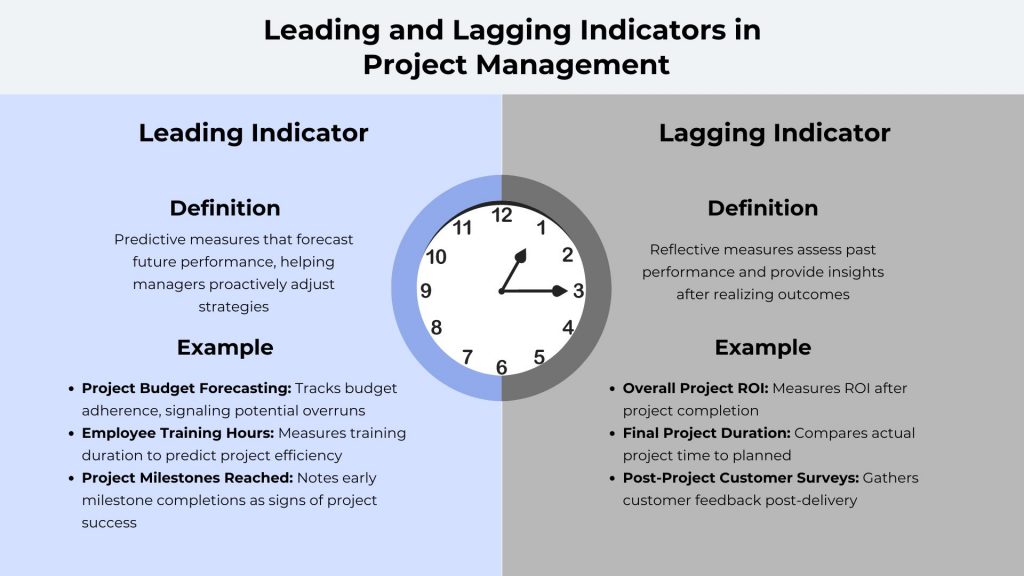
Maintaining a well-structured timeline in project management is essential for successfully delivering any project. Among the numerous strategies employed to achieve this, the concepts of leads and lags stand out as pivotal tools. These techniques allow project managers to adjust the sequencing and timing of activities, facilitating a more efficient and flexible project schedule.
By leveraging leads and lags, managers can optimize resources, improve workflow, and ensure project milestones are timely. This article explores the importance of leads and lags in project management, highlighting how they can enhance scheduling practices and contribute to the overall success of a project.
Table of Contents:
- What are Leads and Lags in a Project?
- What Are Leads and Lags Used For?
- Lead vs. Lag
- What are Leading and Lagging Indicators in Project Management?
- Example of lead and lag
- Conclusion
What are Leads and Lags in a Project?
Leads and lags In project management are essential techniques for optimizing schedules and improving efficiency. Lag refers to the delay before the next activity in a project’s timeline can begin. This delay can occur due to resource constraints, physical limitations, or the need to wait for specific dates or events. For instance, a lag might happen in a construction project while waiting to deliver materials. In project diagrams, lags with plus signs (+) indicate the additional time required between tasks.
Leads, on the other hand, involve the overlap of scheduled activities, allowing one phase of a project to start before the previous phase ends. This overlap is possible when there are no physical barriers preventing the next activity from beginning early. For example, coding might begin in software development while the design phase is still in progress if the initial design elements are ready. In project diagrams, leads are represented by subtraction symbols (-), as they reduce the overall project duration by allowing tasks to occur simultaneously.
By effectively using leads and lags, project managers can improve scheduling flexibility and ensure projects stay on track. These techniques help anticipate delays and find opportunities to accelerate progress, ultimately contributing to successful project completion. Mastery of leads and lags allows for better planning and resource management, ensuring projects are completed efficiently and within their planned timelines.
What are Leads and Lags Used for?
Leads and lags are critical scheduling tools in project management that significantly influence project efficiency and outcome. These tools manage the sequence and timing of tasks within a project, ensuring that all activities are executed in the most effective manner possible. Understanding how to use leads and lags allows project managers to fine-tune the project timeline, providing better control over project progression and delivery dates.
Leads are used to overlap tasks, allowing a successor task to commence before the predecessor task has been fully completed. This can effectively reduce the overall duration of the project, facilitating faster completion and potential cost savings. For instance, in a software development project, the testing phase might begin concurrently with the later stages of development, speeding up the project timeline.
On the other hand, lags introduce intentional delays between tasks to ensure that each task is started only when certain conditions are met, such as the curing of materials in construction or the approval of a project phase in regulatory environments. This careful timing helps prevent rework and errors by ensuring tasks are only started when all necessary prerequisites are met. Together, leads and lags help project managers optimize their project schedules, maximize resource utilization, and enhance the project’s overall success.
Lead vs. Lag
In project management, leads and lags are vital scheduling tools that optimize project timelines and task sequencing. This detailed comparison outlines their definitions, purposes, and impacts on project efficiency and resource allocation.
| Aspect | Lead | Lag |
| Definition | Lead is an acceleration of the successor activity and can be used only on finish-to-start activity relationships | Lag is a delay in the successor activity and can be found in all activity relationship types |
| Relationship Types | Found only in activities with finish-to-start relationships: A must finish before B can start | Found in all activity relationship types: finish-to-start, start-to-start, finish-to-finish, and start-to-finish |
| Purpose | Used to overlap tasks to save time, reducing the overall project duration | Used to ensure necessary conditions or resources are available before the next activity begins |
| Representation | Represented by subtraction symbols (-) in network diagrams, indicating a reduction in the total project timeline | Represented by plus symbols (+) in network diagrams, indicating additional time added to the project schedule |
| Example | In software development, coding might start two days before the design phase is completed if initial design components are read | In construction, a lag might occur while waiting for concrete to cure before starting the next phase |
| Scheduling Impact | Helps project managers identify areas where tasks can overlap, allowing for more efficient scheduling and resource allocation | Helps project managers account for dependencies that require waiting periods, avoiding potential delays and ensuring smooth transitions between tasks |
| Project Type Suitability | Essential for projects with flexible timelines where tasks can be initiated concurrently without waiting for prior tasks to conclude | Essential for projects with fixed dependencies where the completion of one task is necessary before another can begin |
| Time Management | Aims to reduce the project timeline by allowing simultaneous task execution | Ensures that there is adequate time between tasks to meet prerequisites and avoid premature starts |
| Resource Management | Optimizes the use of resources by enabling tasks to start earlier, thus improving overall productivity | Helps manage resources efficiently by scheduling activities based on resource availability and project needs |
| Critical Path Analysis | Can shorten the critical path by overlapping tasks, thereby potentially reducing the total project duration | Can lengthen the critical path if additional time is required between critical activities, impacting the project’s completion time |
What are Leading and Lagging Indicators in Project Management?
Lead and Lag indicators in project management are essential tools for evaluating and guiding a project’s progress. These indicators help project managers assess past performance and predict future outcomes. Understanding these indicators’ differences is crucial for effective project planning and execution.
Leading indicators in project management are proactive measures that predict future performance and provide early warnings about potential issues. These indicators are extremely valuable because they allow project managers to make adjustments before outcomes are finalized, potentially steering projects towards more successful paths.
Examples of leading indicators might include the number of new initiatives launched to improve product quality or the rate of employee engagement in key activities. Since these indicators forecast future results, they enable managers to implement preventative measures and optimize strategies to achieve desired goals.
Lagging indicators, on the other hand, are used to assess the effectiveness of project activities after they have occurred, providing a clear, objective record of outcomes. Common examples include the total sales at the quarter’s end or the incidents reported after implementing a new safety protocol.
These indicators are valuable for evaluating the success of completed actions and are straightforward to measure and validate. While they cannot influence future outcomes, lagging indicators are crucial for confirming the results of project initiatives and are fundamental to historical performance analysis, helping project teams understand what worked well or what areas require improvement.
Example of Lead and Lag
Understanding the practical application of lead and lag in project management can significantly enhance efficiency and coordination among various project tasks. Consider a typical residential construction project to illustrate how lead and lag function:
During a residential construction project, the contractor starts by mapping out a list of sequential and dependent activities. These activities are grouped into major phases: design, construction, utility installation, and finishing touches. Within these broad categories, specific tasks such as drafting blueprints, excavation, framing, plumbing, electrical installation, drywalling, painting, window installation, and landscaping are identified. Each task has specific dependencies that determine when it can begin.
For instance, the task of drywalling cannot commence until the electrical wiring is in place because the wiring needs to be covered by the drywall. This is a classic example of a lag: the start of the drywalling (successor activity) is delayed until the completion of the electrical wiring (predecessor activity). This could be noted as FS + 2, meaning the drywalling starts two days after the electrical work is completed under a finish-to-start (FS) dependency.
Conversely, an example of a lead in this scenario could involve the framing and electrical wiring. While the house framing needs to begin first, the entire framing process does not need to be complete before starting the electrical work. Thus, if electrical work starts three days after framing begins, this is represented as SS – 3. This signifies a start-to-start (SS) relationship with a three-day lead, allowing the electrical wiring to commence before the framing is complete, thereby overlapping the tasks and saving time.
By effectively managing these leads and lags, a project manager can optimize the schedule, ensuring that tasks are completed as efficiently as possible while adhering to necessary sequential dependencies. This strategy prevents unnecessary delays and maximizes resource utilization throughout the project.
Conclusion
Leads and Lags are vital tools in project management that help optimize task scheduling and ensure efficient project execution. By strategically implementing leads, project managers can accelerate project timelines by overlapping tasks where feasible. Conversely, employing lags allows for the necessary preparation and completion of dependent tasks, ensuring that each project phase progresses smoothly without disruptions. Understanding and using these tools effectively can significantly enhance a project’s ability to meet its deadlines and objectives, making them indispensable for successful project management.
If you’re looking to deepen your understanding of project management principles and master the use of tools like leads and lags, consider enrolling in the PMP Certification Training offered by Invensis Learning. This course will equip you with the knowledge and skills necessary to excel in project management roles across various industries. Discover more about the PMP certification course and take your project management career to the next level!
















